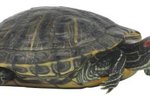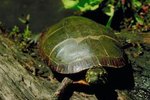
With nearly 300 species of turtles across the world, identification of a specific type of baby turtle can be difficult without expert help. However, the identification markings on their head, neck and shell, as well as the location in which the turtle was found, can assist in identifying the most common types of baby turtles.
Baby Turtle Head and Neck Markings
The pattern and color of the head and neck markings of a turtle can be the first observational step taken to identify a baby turtle. With base colors ranging from brown to olive green to green, the head and neck patterns on a turtle can be mottled (uneven splotches of color that do not form a pattern), solid, spotted or striped. The markings could be red, orange or yellow in color. Each combination of patterns and colors can indicate a specific type of turtle.
Baby Turtle Shell Top Markings
The pattern on the shell of a baby turtle can be spotted, striped, a solid color, reticulated (forming a map-like pattern) or marked with rings. The shell can be smooth, ridged or leathery when touched. The shell also may be domed (arched) or flat, depending on turtle type. The box turtle is commonly found in North America and can be partially identified by his dark brown domed shell with yellow striped markings.
Baby Turtle Shell Bottom Markings
The bottom of the turtle’s shell has a divided or sectioned look, and the number of sections on the bottom of a turtle’s shell helps with identification. Turtles can have anywhere from one to 12 sections on the bottom of their shells. Some turtles also have a "hinge" that allow them to completely close their shell as protection from predators. Since only a limited number of turtles have the hinge, such as box turtles and mud turtles, its presence can help with identifying baby turtles.
Baby Turtle Locations
The location in which a baby turtle is found also plays a large part in identification, as some species are located only in certain areas of the world. There are desert turtles, sea turtles, turtles that live in ponds and those that thrive on land and in forests. Some turtles, such as the Loggerhead turtle, are found only in tropical environments.
With hundreds of turtle species in the world, it is important to carefully observe distinguishing characteristics to correctly identify baby turtles. These characteristics can include markings on the head, neck and shell of the turtle. If questions still remain, a veterinarian or local wildlife expert may be able to help with more conclusive identification.
References
Resources
Photo Credits
-
Medioimages/Photodisc/Photodisc/Getty Images
Writer Bio
Lynn Peterson is a professional writer and editor with more than 15 years of experience in the publishing, marketing, fund-raising and insurance industries. Peterson is the managing editor for three niche market magazines and a freelance writer specializing in web content.




